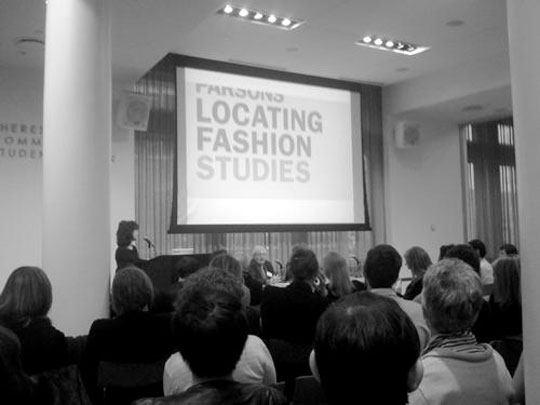 Where does one locate the study of dress and fashion within the academic domain? Where are there sites for research into this field? What are the tools used to create a discourse on and about the clothed body? What on earth are fashion and fashion studies anyway? These are a sample of questions used to frame Parsons’ groundbreaking symposium titled Locating Fashion/Studies, which was held at the Theresa Lang Community Center on November 12 and 13, 2010.
Where does one locate the study of dress and fashion within the academic domain? Where are there sites for research into this field? What are the tools used to create a discourse on and about the clothed body? What on earth are fashion and fashion studies anyway? These are a sample of questions used to frame Parsons’ groundbreaking symposium titled Locating Fashion/Studies, which was held at the Theresa Lang Community Center on November 12 and 13, 2010.
The symposium was both an inauguration of the newly minted MA Fashion Studies program and an opportunity for fashion studies heavyweights to gather and critically engage with fashion as practice, as material culture and as theory. The speakers addressed the above questions through research topics as rich and as varied as global denim, curatorial approaches to displaying fashion and fashioning everyday masculinity. It was an exciting event for us—the program’s inaugural class—to meet and engage with our heroes and to locate potential research sites. However, after the symposium had come to an end, we were still left grappling with what exactly fashion studies is, and where exactly we fit within the ivory towers of academia.
On account of the fact that fashion studies is a difficult field to explain to those outside of the protective bubble of the academy, one of our hopes was that we would leave the event with a tidy definition that we could parlay to well-meaning friends and relatives, many of whom still believed that we were off in New York designing haute couture for Project Runway. Rather, we left with the realization that it is not just we students who struggle to define the nature and purpose of a master’s degree in fashion studies, but that our teachers and mentors do as well.
A common catchall explanation that emerged amongst us was one that broadly explained fashion studies as an “interdisciplinary” or “collaborative” approach to the study of fashion in all its facets. Yet this meager explanation seemed woefully inadequate after witnessing firsthand the breadth and potential of the field that was demonstrated at the symposium. Reconsidering these vague terms, in the days that followed we returned over and over to the definition that we were provided with from day one: students of fashion studies “explore fashion as object, image, text, practice, theory, and concept and develop a critical understanding of fashion and its complex global intersections with identities, histories, and cultures in the contemporary world.” Deconstructing this definition, the boundless scope of our potential research sites becomes evident.
Fashion itself is an enormously broad category, encompassing everything from the personal choices one makes every morning as one prepares one’s self for the social world (whether that includes practices of bathing and adornment, acts of dressing, or rituals and preparations) to the complex and intricate way the fashion system operates locally or globally (from the designers, manufacturers, and marketers to the journalists, buyers, advertisers, and consumers).
In the brief time since we began our studies, we have discussed topics as diverse as the gendered identity and cultural impact of the stiletto heel; the way fashion is represented in Richard Avedon’s 1950s Vogue photographs; the manner in words and layout design have been manipulated to create a particular editorial effect in fashion magazines; and the changing dress behavior of youth subcultures, to name but a few. Examining fashion as object, image, text and practice, respectively, the breadth of the field has become readily apparent while the very definition of fashion has been radically reappraised.
Because these different facets of fashion warrant different approaches, students of fashion studies must ask questions about the theories, concepts, and methods we can use to conduct research in this field: should we use a text- and image-based archival approach, a more ethnographic approach that involves participant observation and interviewing, or should such methodological decisions be left in the hands of the individual researcher?
In many ways, the nature of the field and our own diversity beg for a collaborative approach. Our backgrounds are a testament to this diversity. Just this year, our students have come to the program from disciplines as diverse as art and art history, linguistics, anthropology, marketing, journalism, and even biochemistry. In short, we studied almost everything, and now we study almost everything as it relates to and is mirrored by fashion in all its various guises and forms.
Yet, as we study fashion in all its incarnations, we cannot help but also reflect on the study of fashion itself. In establishing the character of our program, we are exploring our field more introspectively, asking which theories should be foregrounded and which concepts are most crucial to our understanding.


























